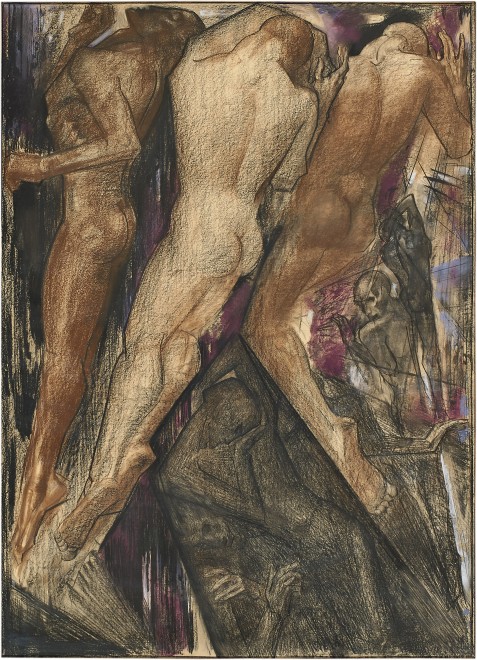Provenance
G.F.H. (Frits) van Kooten Kok, The Hague, The Netherlands;
G.F.H. van Kooten Kok jr., on loan to the Stedelijk Museum, Amsterdam, 1935;
G. Oudshoorn, The Hague, The Netherlands;
Mrs. S.H. Oudshoorn-Spaan, The Hague, The Netherlands;
Mrs. Tine Bottema, The Hague, The Netherlands;
Sale, Christie’s Amsterdam, 7 December 1994, lot 246;
Private collection, The Netherlands
Exhibitions
The Hague, Pulchri Studio, Hollandsche Teeken-Maatschappij 42ste Tentoonstelling , 6 – 30September 1919, no. 42.
Leiden, Stedelijk Museum De Lakenhal, Willem van Konijnenburg ,
5 April – 7 May 1922, no. 12.
Amsterdam, Arti et Amicitiae, Tentoonstelling van werken door H.P. Berlage, W.A. van Konijnenburg en R.N. Roland Holst , 8 November – 13 December 1922, no. 6.
The Hague, Pulchri Studio, Eeretentoonstelling W.A. van Konijnenburg ,
12 February – 8 March 1928, no. 17.
Amsterdam, Stedelijk Museum 1935, permanent loan, no. 138
Utrecht, Centraal Museum, Willem van Konijnenburg 1868-1943 , 26 October – 2 December 1990.
Assen, Drents Museum, Willem van Konijnenburg 1868-1943 , 15 December 1990 – 11 February 1991.
Breda, De Beyerd, Wendingen 1918-1932. Architectuur, kunst en vormgeving , 23 March – 13 May 2001.
Literature
Dr. G. Knuttel, Elsevier magazine (edition LIX) 1920 pp. 3 -4 (ill.) review of the 1919 exhibition)
Albert Plasschaert, “Willem van Konijnenburg” in: Wendingen 4, Vol. 1/2’, 1921, pp. 4-13, ill. p. 20.
Franz Dulberg, “Willem van Konijnenburg”, in: Winterboek VI, Amsterdam, 1927, pp. 52-90.
H. de Boer a.o., Willem A. van Konijnenburg. Schilderijen en teeekningen in de verzameling
G.F.H. van Kooten Kok , part II, The Hague 1929, ill. pp. 144-145 with a poem by P.G. Boutens
Willem A. van Konijnenburg. Gemälde und Zeichnungen Sammlung G.F.H. van Kooten Kok , The
Hague 1929.
Willem A. van Konijnenburg. Paintings and drawings belonging to the collection of G.F.H. van
Kooten Kok , The Hague 1929.
Gerard Knuttel, Willem van Konijnenburg , Amsterdam (Paletreeks), 1941, ill. p. 37.
Mieke Rijnders, Willem van Konijnenburg 1868-1943 , Assen 1990, p. 104, ill. p. 235 (nr IX).
Mieke Rijnders, Willem van Konijnenburg, Leonardo van de Lage Landen , Zwolle 2008, p. 312, no. 143 ill.
Publications
Praedestinatie is one of the finest drawings by Willem van Konijnenburg. It belongs to a program
of six dances (fig. 1): Dans der jonkheid (Dance of Youth), 1917; Rituele dans (Ritual Dance),
1918; Fatalisme (Fatalism), circa 1918, Heksendans (Witch Dance), 1919 and Krijgsdans (War
Dance), 1919. Together with Jan Toorop, Leo Gestel and Jan Sluijters, the Hague artist Willem
van Konijnenburg represented the face of Dutch modern art abroad during the Interbellum. In his
youth, Van Konijnenburg was famous not so much for his artistic skills as for his dandy-like
appearance and his active involvement in The Hague art circles. From 1900 on, he abandoned The
Hague School of Impressionism and started to develop his own classical idiom. Using an invented
system of rules in which symmetry and mathematical patterns played an important role, Van
Konijnenburg created harmonious compositions, which won him considerable fame. His theme
was no longer landscape, but the idealized individual. Van Konijnenburg’s unique interpretation
of modern art was considered highly innovative at the time. He received important commissions,
among them the relief in Berlage’s Gemeentemuseum in The Hague, and participated in numerous
exhibitions.
When the well-respected art critic Albert Plasschaert announced in 1912 that Van Konijnenburgh
was a better draughtsman than his contemporary Jan Toorop (1858-1928), a true rivalry ensued.1
In 1919 when the present series was first exhibited at Pulchri Studio in The Hague, Van
Konijnenburg demanded to be exhibited next to Toorop, surely to enable a comparison. While
Toorop was represented with eleven drawings, Van Konijnenburg contributed two series: the
present large format pastels and five slightly smaller anatomical studies to demonstrate that he
mastered rendering the body accurately, securing his nickname the ‘Leonardo of the Low
Countries.’ Toorop and Van Konijnenburg could not have been more different in their choice of
color scheme and rendering of line. Whereas Toorop’s interest in the Flemish Primitives was
evident in his work, Van Konijnenburg was considered the modern Renaissance artist and esthetic
intellectual. That all six drawings were presented in monumental artists’ frames surely helped
solidify his reputation.
Van Konijnenburg was, like Piet Mondriaan, an avid dancer. As fellow artist Chris de Moor
noted “Mondriaan en “Konijn” dansten beiden urenlang de tango, de een in Parijs, de ander
in de House of Lords in den Haag” (Mondriaan and “rabbit” both danced tango for hours,
one in Paris and the other in the House of Lords in The Hague).2 The present Predestination
and the other drawings of the series, executed between 1917 and 1919, all have an ecstatic
dance as theme. Five of the six drawings, exhibited in a group exhibition at Pulchri Studio in
The Hague in 1919 were acquired shortly afterwards by Frits van Kooten Kok and remained
together until they were offered for sale at the 1994 auction when they all diverged. Fritz
Kok, a merchant in tea and quinine, amassed mostly works by Van Konijnenburg for his
collection. When Franz Dülberg visited Kok’s stately residence in 1921, he referred to it as
the “real Museum Konynenburgs”.3
